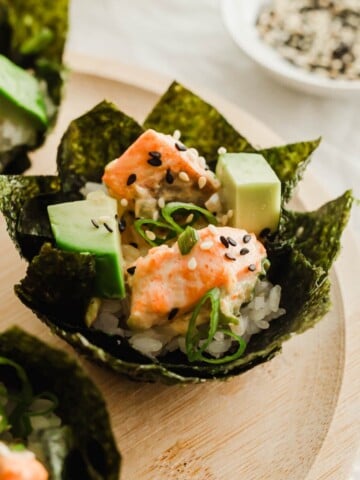This recipe for Korean Seaweed Rice Snacks (Bugak) features seaweed coated with a glutinous sticky rice mixture that is deep-fried until crisp and crunchy.

Want to save this recipe?
Enter your email & I'll send it to your inbox. Plus, get great new recipes from me every week!
What is bugak?
Bugak is a Korean deep-fried vegetable or seaweed with a coating of glutinous rice paste.
It is typically eaten as banchan (with rice and other dishes such as tofu, potatoes), or as a snack.
There are many types of bugak, using various vegetables or leaves.
Why you'll love this recipe
This recipe is inspired by the Korean seaweed snacks (bugak) I tried from Costco, which are crispy, light, sweet and slightly salty.
There's no need to use a dehydrator to make this.
Using an oven to dry the seaweed chips cuts down on the preparation time, similar to making Crispy Crunchy Mochi Bites.
This method also produces a light, crispier bugak and prevents any oil from splattering (from any residual moisture in the rice).
You can make double or triple the recipe to make a large batch of the seaweed chips and keep them in a cool location indefinitely.
When you have a hankering for the seaweed rice snacks, easily fry these naturally vegan, gluten-free and dairy-free snacks up.
Ingredients you'll need
You'll need a handful of ingredients to make these truly delicious snacks!
- cooked glutinous sticky rice: freshly cooked and still warm so it can be easily spread; for this recipe we're using short-grained glutinous sticky rice (also known as sushi rice)
- sea salt
- granulated sugar
- mushroom powder or dashi powder: optional, but adds extra umami flavor
- sesame oil: for additional aroma
- sesame seeds: adds a little crunch; you can use black or white sesame seeds
- seaweed (gim): also known as nori in Japanese and used to roll sushi; the seaweed comes packaged in large square sheets and is unflavored/unseasoned
You can find these ingredients at your local Asian grocery store or supermarket.
How to make them
Make the seaweed rice chips
Cook the glutinous sticky rice using a rice cooker or small saucepan.
In a bowl, add the hot, cooked sticky rice along with the salt, sugar, mushroom powder and sesame oil.
Mix well to combine.
Spread the rice mixture onto a large piece of parchment paper.
Sprinkle the sesame seeds over top.
Place a piece of seaweed top of the warm rice and press firmly so it sticks.
Place a cooling rack over a large baking sheet (18" by 13").
Transfer the parchment paper (with the rice/seaweed) over the cooling rack.
Oven-dry at 250F for 30 minutes.
Once the rice is partially dry, carefully flip the parchment paper and peel it off the rice. (There may be some sticky rice left behind, that's OK, you can scrape it off and place it onto the seaweed).
Remove the parchment paper and place the seaweed back onto the cooling rack.
Continue oven-drying at 250F for another 30 minutes.
Use a pair of kitchen scissors to cut the seaweed into smaller pieces, about 1" in size.
Spread the seaweed pieces on the cooling rack, giving sufficient room for the seaweed to dry.
Reduce oven temperature to 200F and continue oven-drying for 1 hour, or until completely dry and hard.
Turn off the oven and let it cool. If not frying right away, cool and store in an airtight container (with silica packets -- do not eat!).
When ready to fry
Place the seaweed pieces onto a baking sheet at 200F, to warm up, about 15 minutes.
Heat a small pot of frying oil to 425F.
Add 1-2 seaweed pieces to the oil and quickly agitate with a pair of chopsticks until the rice floats and puffs up (a few seconds).
Remove and drain on paper towel.
Repeat with the remainder.
Enjoy immediately or cool completely and store in an airtight container.

Substitutions
In place of the cooked sticky rice, you can also use rice paper (also used in Vietnamese salad rolls (goi cuon)).
Use a similar method by wetting the rice paper, sticking it to the seaweed, oven-drying it before cutting into chips, and deep-frying them.
Feel free to add different flavorings or spices, such as furikake.
Expert tips
Ensure that the frying temperature reaches 425F. If the oil is not hot enough, the seaweed/rice will not puff up.
However, too hot of a frying temperature can cause the rice to burn.
You can also choose to season the bugak after it has been fried.
Don't wait too long to cut the seaweed into pieces during the oven-drying process. If it's overly dried, it may be too difficult to cut.
Make sure the seaweed pieces are SUFFICIENTLY DRIED before frying.
Other recipes you may like
Be sure to check out these recipes:
Prawn Crackers/Shrimp Chips (Keropok)
Chinese Fried Sesame Balls (Jian Dui)
Ham Sui Gok 咸水角 (Fried Glutinous Rice Dumplings)
Crispy Crunchy Mochi Bites (Fried Kirimochi)
Let me know if you try out this recipe -- tag me on Instagram @siftandsimmer or leave me a comment/rating below.

Korean Seaweed Rice Snacks (Bugak)
For accuracy and precision in baking recipes, use weight (metric) measurements when available.
Ingredients
- 1 C cooked short-grain glutinous sticky rice freshly cooked and warm
- ¼ teaspoon sea salt or to taste
- 2 teaspoon granulated sugar
- ¼ teaspoon mushroom powder or dashi powder optional
- 1 teaspoon sesame oil
- 1 tablespoon sesame seeds
- 1 pc seaweed nori/gim
Instructions
For key visual step-by-step photos, refer to the body of the post.
Make the seaweed rice chips:
- Cook the glutinous sticky rice using a rice cooker or small saucepan.
- In a bowl, add the hot, cooked sticky rice along with the salt, sugar, mushroom powder and sesame oil.
- Mix well to combine.
- Spread the rice mixture onto a large piece of parchment paper.
- Sprinkle the sesame seeds over top.
- Place a piece of seaweed top of the warm rice and press firmly so it sticks.
- Place a cooling rack over a large baking sheet (18" by 13").
- Transfer the parchment paper (with the rice/seaweed) over the cooling rack.
- Oven-dry at 250°F/121°C for 30 minutes.
- Once the rice is partially dry, carefully flip the parchment paper and peel it off the rice. (There may be some sticky rice left behind, that's OK -- scrape it off and stick it back onto the seaweed).
- Remove the parchment paper and place the seaweed back onto the cooling rack.
- Continue oven-drying at 250°F/121°C for another 30 minutes.
- Use a pair of kitchen scissors to cut the seaweed into smaller pieces, about 1" in size.
- Spread the seaweed pieces on the cooling rack, giving sufficient room for the seaweed to dry.
- Reduce oven temperature to 200°F/93°C and continue oven-drying for 1 hour, or until completely dry and hard.
- Turn off the oven and let it cool. If not frying right away, cool and store in an airtight container (with silica packets -- do not eat!).
When ready to fry:
- Place the seaweed pieces onto a baking sheet at 200°F/93°C, to warm up, about 15 minutes.
- Heat a small pot of frying oil to 425°F/218°C.
- Add 1-2 seaweed pieces to the oil and quickly agitate with a pair of chopsticks until the rice floats and puffs up (a few seconds).
- Remove and drain on paper towel.
- Repeat with the remainder.
- Enjoy immediately or cool completely and store in an airtight container.
Nutrition
The nutritional information provided should be considered as approximate and is not guaranteed. Please use your best judgment to ensure food is safely prepared and/or a good fit for your diet.








Raymund | angsarap.net
Ohh this is something new to me and I bet with those ingredients the texture will be amazing. Definitely one of the snack that I would really love
2pots2cook
So bursting with heath!
Linsey
Wow!! These Korean seaweed rice snacks look exactly like the ones sold in Costco. They are so tasty, crispy and I can never just eat one piece. Now I can make them at home. Thanks Michelle!
Heidi | The Frugal Girls
I love that you don't need a dehydrator to make this, just a sauce pan. This is such a delicious salty snack idea... YUM!